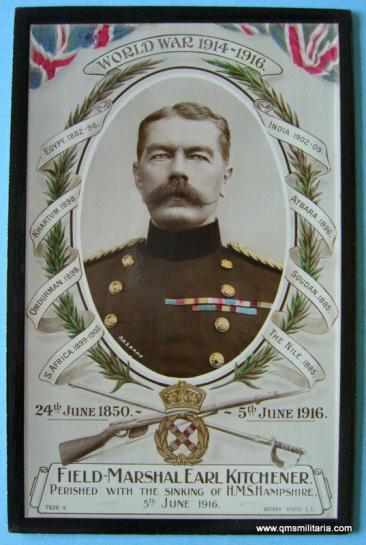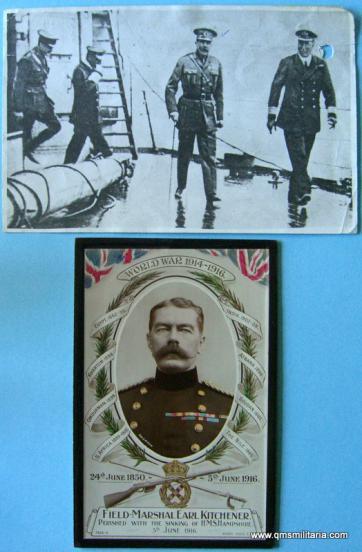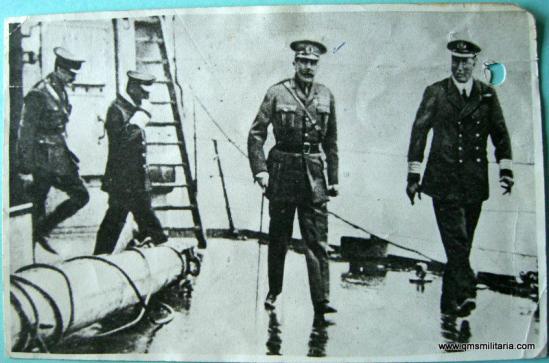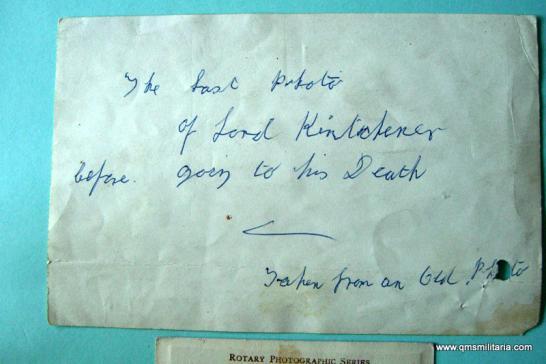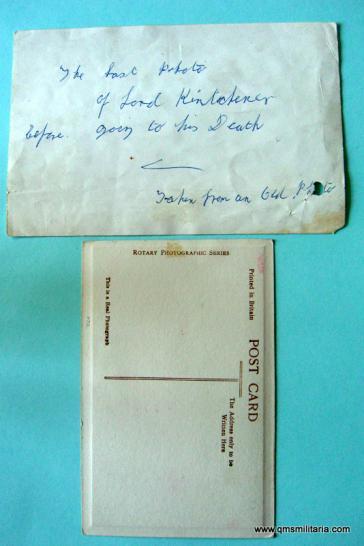WW1 Memorial Postcard Earl Kitchener ( 1850 - 1916 ), Field Marshal plus a copy photograph of the last known photograph of him before he met his death
An original WW1 era memorial card of Field Marshal Earl Kitchener with black borders and reference to his death on the 5th June 1916 with the sinking of HMS Hampshire. This comes with an "old" copy (one punch hole) of allegedly the last known photo of him alive. Photo is in poor to average condition, postcard is in excellent, Postally unused, condition.
The copy photograph was obtained from the Ministry of Defence Whitehall Librarian in the early 1980s, but it was old even then! On the reverse in ink "The last photo of Lord Kitchener before going to his death - taken from an old photo".
It was published in the Daily Mail on 19th February 1935 under the heading "Scoops with the Camera". It shows Lord Kitchener inspecting the flagship HMS Iron Duke at Scapa Flow on the 5th June 1916 accompanied by Admiral Sir Frederic Charles Dreyer ( 1878 - 1956), captain of the Iron Duke. Following behind him are Lord Jellicoe with whom he had just lunched, and Colonel Fitzgerald, Lord Kitchener's military secretary, who also perished aboard the Hampshire a few hours later. See this link for more details:
http://imagesonline.bl.uk/index.php?service=search&action=do_quick_search&language=en&q=%23150640
Immediately after the battle of Jutland in which she played her part, HMS Hampshire was ordered to carry Lord Kitchener, The Secretary of State for War, from Scapa Flow on a diplomatic mission to Russia via the port of Arkhangelsk. Due to the gale-force conditions, it was decided that Hampshire would sail through the Pentland Firth, then turn north along the western coast of the Orkney Islands. This course would provide a lee from the strong winds, allowing escorting destroyers to keep pace with her. She departed Scapa Flow at 16:45 and about an hour later rendezvoused with her two escorts, the Acasta-class destroyers Unity and Victor. As the ships turned to the northwest the gale increased and shifted direction so that the ships were facing it head on. This caused the destroyers to fall behind Hampshire. As it was considered unlikely that enemy submarines would be active in such conditions, Captain Savill of the Hampshire ordered Unity and Victor to return to Scapa Flow.
Sailing alone in heavy seas, Hampshire was approximately 1.5 miles off the mainland of Orkney between Brough of Birsay and Marwick Head at 19:40 when an explosion occurred and she heeled to starboard. She had struck one of several mines laid by the German minelaying submarine U-75 on 28/29 May 1916, just before the Battle of Jutland. The detonation had holed the cruiser between bows and bridge, and the lifeboats were smashed against the side of the ship by the heavy seas when they were lowered. About 15 minutes after the explosion, Hampshire sank by the bows.Of the 655 crewmen and 7 passengers aboard, only 12 crewmen on two Carley floats managed to reach the shore alive; Kitchener and his staff were lost.
Coll.
Code: 55843

